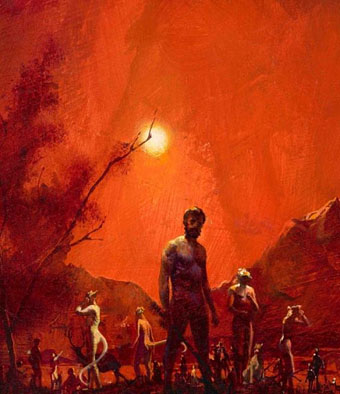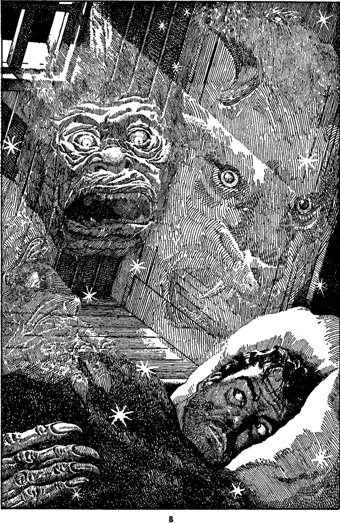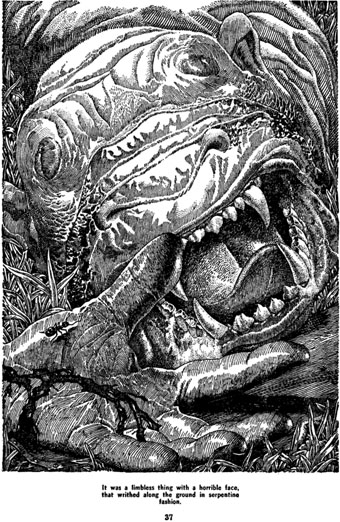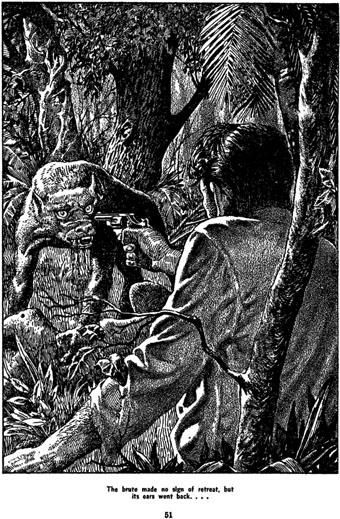
Painting by Paul Lehr for the Berkley Highland paperback (1970).
The Island of Doctor Moreau is one of those Victorian novels everyone thinks they know well enough from various film or television adaptations, even when those adaptations have accreted a layer of misconception around the story. In the case of HG Wells’ novel we have The Island of Lost Souls (1932), which the author loathed for its vulgarisations, and which he helped get banned in Britain for many years; the 1977 film directed by Don Taylor which nobody seems to have a good word for; and Richard Stanley’s 1996 adaptation which might have been worthwhile if he hadn’t been kicked off his own film shortly after shooting began. These films may not distort Wells’ novel as much as the numerous adaptations of Dracula, and Dr Jekyll and Mr Hyde, but they still present a skewed impression of a book which is stranger and more disturbing than any screen version.
Wells’ story purports to be the written account of one Edward Prendick who finds himself on Moreau’s remote island after a shipwreck. The bare bones of the story are familiar: Prendick is rescued by Moreau’s alcoholic assistant, Montgomery, and ends up on the island against the doctor’s wishes. The story deviates from the films very quickly by introducing a setting that’s commonplace in Victorian literature but which Hollywood abhors: the all-male enclave. The Island of Lost Souls put “Edward Parker” on the island with his fiancée but went further (to the outrage of Wells and the British censors) by adding a sexy Panther Woman to the menagerie with whom Moreau encourages Parker to mate. There are women among the “Beast People” in Wells’ novel but we’re assured that they’re as grotesque as their male counterparts.

Illustration by Lawrence Sterne Stevens (aka Lawrence) for Famous Fantastic Mysteries, October 1946.
And here we have the second major difference between novel and films: given the limitations of makeup effects—not to say the limitations of the human body—it’s no surprise that the Beast People in the films tend to be like Star Trek aliens, mostly humanoid with a variety of different facial features. Stan Winston’s effects in the 1996 film were the most successful, and were aided considerably by casting a range of actors of different sizes and shapes. All the films tend to present single types, however: wolf-man, cat-woman, bear-man, etc. Wells was writing in 1896 yet his imagination had already brought him this far:
The two most formidable Animal Men were my Leopard-man and a creature made of hyena and swine. Larger than these were the three bull-creatures who pulled in the boat. Then came the silvery-hairy-man, who was also the Sayer of the Law, M’ling, and a satyr-like creature of ape and goat. There were three Swine-men and a Swine-woman, a mare-rhinoceros-creature, and several other females whose sources I did not ascertain. There were several wolf-creatures, a bear-bull, and a Saint-Bernard-man. I have already described the Ape-man, and there was a particularly hateful (and evil-smelling) old woman made of vixen and bear, whom I hated from the beginning. She was said to be a passionate votary of the Law. Smaller creatures were certain dappled youths and my little sloth-creature. But enough of this catalogue.
Later on Moreau has this to say:
“The fact is, after I had made a number of human creatures I made a Thing—” He hesitated.
“Yes?” said I.
“It was killed.”
“I don’t understand,” said I; “do you mean to say—”
“It killed the Kanaka—yes. It killed several other things that it caught. We chased it for a couple of days. It only got loose by accident—I never meant it to get away. It wasn’t finished. It was purely an experiment. It was a limbless thing, with a horrible face, that writhed along the ground in a serpentine fashion. It was immensely strong, and in infuriating pain. It lurked in the woods for some days, until we hunted it; and then it wriggled into the northern part of the island, and we divided the party to close in upon it. Montgomery insisted upon coming with me. The man had a rifle; and when his body was found, one of the barrels was curved into the shape of an S and very nearly bitten through. Montgomery shot the thing. After that I stuck to the ideal of humanity—except for little things.”

Lawrence’s depiction of the limbless Thing.
It’s tempting to wonder what David Cronenberg might have made of this when he was at his Grand Guignol height. Prendick doesn’t tell us much about the appearance of the Beast People (“my eye has had no training in details, and unhappily I cannot sketch”) but he does impress upon us their animal strength, the fearsome demeanour of the predators, and the terror that comes over him when the rebellion against Moreau begins. There’s also a great deal more sympathy for their predicament than one finds in the films, a quality which is probably more striking today with the change in attitudes towards vivisection, and the debates about intelligence in animals. The novel functions very effectively as a horror story but Wells also takes digs at religion: Moreau is god to the Beast People, his word is the Law, and he can punish them in the House of Pain; Prendick later uses their fear and superstition to keep them at bay. In the final chapter, the author turns the mirror towards the reader when Prendick states that his return to Europe is no blessing now that he sees his fellow humans as Beast People of a slightly more sophisticated variety. No Hollywood adaptation would ever challenge its audience in this manner.

China Miéville lists The Island of Doctor Moreau among his favourite novels; I’ve been wondering whether one of China’s favourite authors—William Hope Hodgson—might have been inspired by Wells’ tale. When I was writing about The Time Machine last year I noted the common assumption that the end of the novel is a precursor of Hodgson’s apocalyptic scenes in The House on the Borderland, and in The Night Land. A story of a ship-wrecked sailor would surely have caught Hodgson’s attention, and in the Beast People we may have a precursor of Hodgson’s Swine-Things:
Suddenly, as I watched their grotesque and unaccountable gestures, I perceived clearly for the first time what it was that had offended me, what had given me the two inconsistent and conflicting impressions of utter strangeness and yet of the strangest familiarity. The three creatures engaged in this mysterious rite were human in shape, and yet human beings with the strangest air about them of some familiar animal. Each of these creatures, despite its human form, its rag of clothing, and the rough humanity of its bodily form, had woven into it—into its movements, into the expression of its countenance, into its whole presence—some now irresistible suggestion of a hog, a swinish taint, the unmistakable mark of the beast. (The Island of Doctor Moreau, chapter 9)
*
Thus, I saw the thing more completely; but it was no pig—God alone knows what it was. It reminded me, vaguely, of the hideous Thing that had haunted the great arena. It had a grotesquely human mouth and jaw; but with no chin of which to speak. The nose was prolonged into a snout; thus it was that with the little eyes and queer ears, gave it such an extraordinarily swinelike appearance. Of forehead there was little, and the whole face was of an unwholesome white colour.
For perhaps a minute, I stood looking at the thing with an ever-growing feeling of disgust, and some fear. The mouth kept jabbering, inanely, and once emitted a half-swinish grunt. I think it was the eyes that attracted me the most; they seemed to glow, at times, with a horribly human intelligence, and kept flickering away from my face, over the details of the room, as though my stare disturbed it.
It appeared to be supporting itself by two clawlike hands upon the windowsill. These claws, unlike the face, were of a clayey brown hue, and bore an indistinct resemblance to human hands, in that they had four fingers and a thumb; though these were webbed up to the first joint, much as are a duck’s. Nails it had also, but so long and powerful that they were more like the talons of an eagle than aught else. (The House on the Borderland, chapter 5)
HG Wells was 30 when he wrote The Island of Doctor Moreau; he wrote The Time Machine the year before, and The Invisible Man the year after. A year after that he wrote The War of the Worlds, and throughout this period he was also writing many remarkable short stories for the magazines; an astonishing achievement. He may have hated The Island of Lost Souls but I’ve always been partial to early Hollywood’s hothouse jungles so I have the recent Blu-ray edition on order at the moment. There might be a report concerning this at a later date.
Previously on { feuilleton }
• Harry Willock book covers
• The Time Machine
• The Magic Shop by HG Wells
• HG Wells in Classics Illustrated
• The night that panicked America
• The Door in the Wall
• War of the Worlds book covers

I’ve got a good word to say for the 1977 film: the scene with Richard Basehart as the Sayer of the Law is great. Shame they didn’t get George C Scott…
http://www.youtube.com/watch?v=8kONqJoTMlk
Yeah, Richard is okay. I don’t mind that film too much although the whole business about turning Michael York’s character into an animal made no sense. There’s also a lot I like about the 1996 film even though it’s deeply flawed and Brando is wholly unbelievable as the driven Moreau. Great title sequence and makeup effects; Fairuza Balk was a sexy cat-girl.
Fairuza Balk can do no wrong.
Read this over the Summer, and immediately read it again. Very affecting and disquieting, and written with substance as implacable and carefully-wrought as antique mahogany furniture. Prompted me to watch the 1977 film again (as Hollywood as you’d expect but OK) and to read Brian Aldiss’s riff on it, ‘Moreau’s Other Island’. The latter just seems like ingenious fluff by comparison, its insubstantial nature shown up by the dark light from Wells’s novella that shines through it.
I’m intrigued to see the famously-beserk 90s film though.